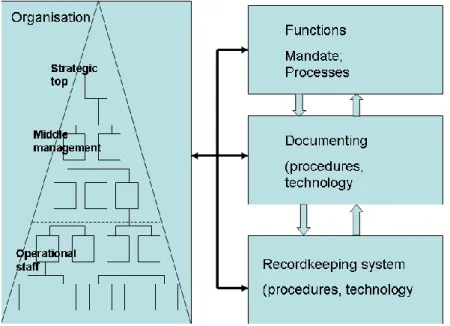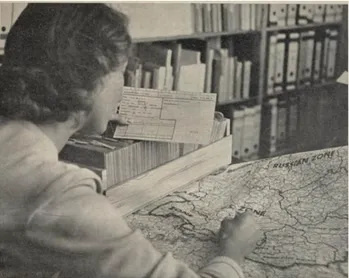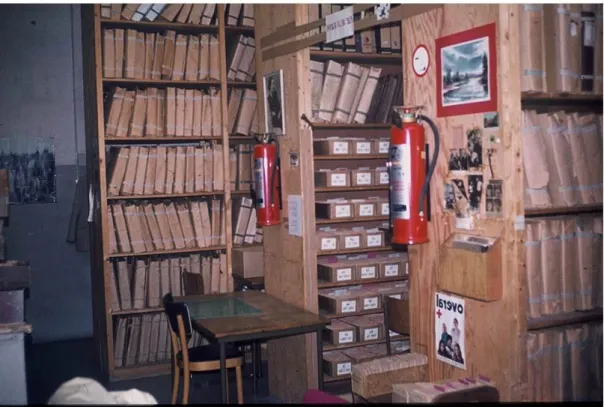Wrapping records in narratives
Representing Context through archival description
Peter Horsman
University of Amsterdam
“The Context is All”
Principle of provenance
The traditional key concept in archival arrangement and description is the Principle of Provenance, which has its roots in the French Respect des Fonds (1842), and even in older archival practice.1 Traditionally, the principle asserts that the records created by an individual or organisation should – or even must – be kept together. Such a whole of records is what the French called a fonds d’archives - a term in the eighties of the 20th century adopted by Canadian archivists -, the Germans call it
Archiv, the Dutch archief, the Italians fondo, US archivists have record groups. Post-modernists use the word the archive, but do rarely refer to a fonds as meant in classic archival theory.
The Dutch interpretation of the principle of provenance added an extra dimension to it: not only the whole of records should be kept, or even brought together, but also the original order of the records within the fonds had to be respected, and eventually restored. In German archival terminology this interpretation is called the Registratur Prinzip. Since its international launching and definition at the Brussels congres 1910 the, what Canadian scholar Terry Eastwood called the external dimension of the principle of provenance has been widely accepted by archival theorists and practitioners. The internal dimension, however, the principle of respecting the original order, encountered more resistance. It is not the place here to discuss this theoretical battle, nor to elucidate in depth the principles.
In 1966 Australian archivist Peter Scott published in the American Archivist a provocative essay “Abandoning the Record Group”, the US implementation of the rather European concept of the
fonds.2 In later work he and a few other Australian archivists developed the Series System, denying the record group or fonds being the top level of arrangement and description. The Australian Series theory, based on continuous organisational change, links the Series to functions, not to one
Inspired by Australian critique and aware of the limitations of the rigid application fonds concept within complex bureaucracies as well as in electronic systems archival theorists like Terry Cook, David Bearman, Laura Millar – and myself, I may add – to look for a more conceptual application of the principle of provenance. In emerging theories since the late eighties provenance is not simply the organisation, the undefinable records creator, but also the business functions, the administrative and documenting processes, and recordkeeping systems. Theo Thomassen coined in 1995 the definition of an archive as process bound information (or should we say process embedded?).3
The Context is all
More conceptually, provenance is now rather defined as context. In 1992 Heather MacNeil wrote a landmark essay: “The Context is All: describing a fonds and its component parts according to the Rules for Archival Description”. Although the focus is still on the fonds – by then only recently discovered by Canadian archivists, the article opens up for a wider view, beyond the archive as a whole of records. 4 In the following years the fonds was gradually de-constructed as a constructable entity and theory about the context developed.
Context Models
Context and Provenance
What then, is the context, and why is it important? How does the concept relate to provenance? Context is not completely different from Provenance, but it is potentially richer, and above all, does not focus on the fonds as a physical entity, but on understanding the meaning of records, how they were created, used, and maintained across space and time.
The context can be seen as everything outside the records that influences their contents and structure. The context of a single document starts with other records in the file, which also may be defined as structure. Trhe context of these documents is the business process in which they are created, received and used – to which they are ‘bound’, to refer to Thomassen. Context is also the persons that were involved in the business process, the organisation at whole, its mandate.
Furthermore it is the technology that is used to create and transmit the information; the system that keeps and maintains them; eventually even the environment of the organisation: clients,
stakeholders, the society. The context, indeed, is an expanding universe.5
(legal basis, juridical system) and the business process. Furthermore he distinguishes the context of creation from the context of recordkeeping. Based on these and other context models I designed a simple model in which I divide the context in four domains; each of these can further be detailed: organisation, functions, documentation, and recordkeeping.7
Four Domain model
Figure 1: four domain model
Each of the domains influence each other, but the documentation domain, that is the creation and use of documents, is rather central to the contents of the recordkeeping system. As German archival theorist Johannes Papritz expressed it: not all processes result in documents; not all documents are captured by the recordkeeping system. 8
Context is never fixed
It is essential to realise that during the life of the records each of the domains in the context may change: organisation, functions, documentation and recordkeeping. The context is never fixed. Records created and used in organisation A for function X, may be reused or modified by
organisation B for function Y, and transferred from the recordkeeping system of organisation A into that of organisation B. Organisation, functions, processes, documentation and recordkeeping, they
all can be viewed as systems with their own dynamics; they are interrelated, but not necessarily behave synchronically.
Netherlands Red Cross Information Bureau: a case study
To illustrate the brief theoretical discourse I use a few examples of the Netherlands Red Cross, a national tracing service. 9
Re-creating records
One of the core series is the card index of the Joodsche Raad, the Jewish Council. This organisation was instituted by the German authorities; one of its tasks was to register all Jews in the Netherlands. After the war the Red Cross Information Bureau used the cards as the basis for its research on what happened to missing persons. The bureau re-used also similar registration systems from Durchgangslager Westerbork, but I will focus on the Jewish Council sytem.
The Series is not homogeneous, different sections of the Council created sub-seris. Abolition of the Council in 1943 meant a first de-contextualisation. a part of the series went ‘underground’.
Recontextualisation happened after the war when the series was incorporated into the Red Cross archive.
Fig 1: Staff member Red Cross, c 1949. Photo H.G.L. Schimmelpenninck. Courtesy Netherlands Red Cross
Use of the cards
The cards were intensively used; new information about the tracing process written on the cards. Also references to files and other documentation.
Almost every card in the series shows traces of the intensive use, first by the Council, possibly after its abolition by other administrations, and clearly by the Red Cross Information Bureau.
Fig 3: Staff Netherlands Red Cross, ca 1949. Photo H.G.L.Schimmelpenninck. Courtesy Netherlands Red Cross.
Different layers
How to deal with these records from an archival point of view? In the old paradigm of restoring the fonds, it would mean rearrangement. But even if that would be possible, it would mean disturbing a reality, destroying another, meaningful order. Maybe a fonds can be reconstructed, the original context not. The only sound method is describing the subsequent contexts and how these are related to the records. Describing at series level which functions the records performed, in what business processes, with what technology and people. That is: representing the context in narratives that help current researchers to interpret the records, how to read them, what the significance of the various codes is.
Personal files
Another, related series that I’d like to use as an example is the person files, the documents created, collected, received and used during the process of tracing missing persons.
At the file level, the series looks homogeneous, all files served the same function: documenting the Red Cross tracing process. Analysis at document level demonstrates the diverse provenance of their contents: some of the records are letters received by the Information Bureau, inquiries, responses; other documents are obviously taken out of other archives previously created by other, mostly contemporaneus, organisations.
Fig 4: Repository Netherlands Red Cross, ca 1980. Courtesy Netherlands Red Cross
Representation
If there is not one original order, such as in this Red Cross case – and actually this happens too often, Petra Links will give an example of how NIOD processed collections in its custody – and if physical re-arrangement according to the orginal order is not possible because of the dynamic character of the contexts of origin, how then to deal with arrangement and description.
explicit by description, representation, only. That is: the representation of contents, structure and context. Taking the given example of the card tray, it is obvious that the contents can hardly be represented at document level. First, because of the quantity (ca 180.000 items – and the cards is by far not the only series in the archive!), second, because of the complexity of the often encoded contents. The power of archival description lies more in the representation of structure and context – and as a matter of fact, that has been the case in archival theory and practice since the publication of the Manual of Arrangement and Description by Muller, Feith and Fruin in 1898.
Layers of representation
Traditionally the structure between the records has been represented in a classification schema of the fonds, a fixed structure. ISAD(G), the International Standard for Archival Description, suggests a hierachy within a fonds. Such a fixed schema, or hierarchy, do not fit in complex cases such as the given example of the Netherlands Red Cross archive. Therefore, I would take the current
arrangement as a given starting point, being just one structure.
This structure may be coincide with the physical structure as it is now to be found in the repository, hidden . Or maybe not, depending of the logistic system in use.
Each of the series or other sub-collections or component parts of the archive, may be represented in narratives, ‘stories’, about what the functions of the records were, who created them, modified and used them, what happened to the records, how to interpret them, etc.
Even the colours on the cards are essential for interpretation: the series has been microfilmed in the fifties, in black and white, and some of these have been digitized. Reading B-W images is technically possible, but interpretation will be difficult.
Data Model
To conclude. An archival representation system consists of at least four types of information: about the actors, that is in classic archival termninology the records creators, the business functions of these actors, the ‘collection”, at any level that is useful, record group, series, class, file .., and finally the repositories in which the records were or are stored. All relationships between these entities are many-many relationships. For each of the entities the International Council on Archives has
developed descriptive standards, which may guide archivists to write their narratives in which the records could be wrapped, to make them useable for research: that is: retrievable and
understandable.
1
2 Peter J. Scott, “The Record Group Concept. A Case for Abandonment,” American Archivist 29 (1966) 493-504. 3 Theo Thomassen, “A First Introduction to Archival Science”, Archival Science 1:4 (2001) 373-385; first
publication in Dutch in: P.J.Horsman, F.C.J.Ketelaar and T.H.P.M.Thomassen (eds), Naar een nieuw paradigma in de archivistiek. (Den Haag, 1999) 11-20.
4
Heather MacNeil, “The Context is All: Describing a Fonds and its Component Parts According to the Rules for Archival Description”, in: Terry Eastwood (ed), The Concept of the Fonds: From Theory to Practice. (Ottawa, 1992) 198-224.
5 Hans Hofman, “Een uitdijend heelal. Context van archiefbescheiden”, in: P.J.Horsman, F.C.J.Ketelaar and
T.H.P.M.Thomassen (eds), Context. Interpretatiekaders in de archivistiek. (Den Haag, 2000) 45-66.
6 Richard Pearce-Moses, A Glossary of Archival and Records Terminology. (Chicago, 2003). Also at:
www.archivists.org/glossary.
7
Peter Horsman, Abuysen ende disordiën. Archiefvorming en archivering in Dordrecht 1200-1920. (Den Haag, 2011. (PhD dissertation, Amsterdam 2009).
8 Johannes Papritz, Archivwissenschaft. (Marburg,, 19832). Band I, 137-138.
9 I thank the staff of the department of Oorlogsnazorg of the Netherlands Red Cross for their kind co-operation.
I owe much to research by Marieke Bos in the course of the master program in Archival Science at the University of Amsterdam, and to the master thesis for the University of Leyden by Raymund Schütz, Vermoedelijk op transport. (2010).




